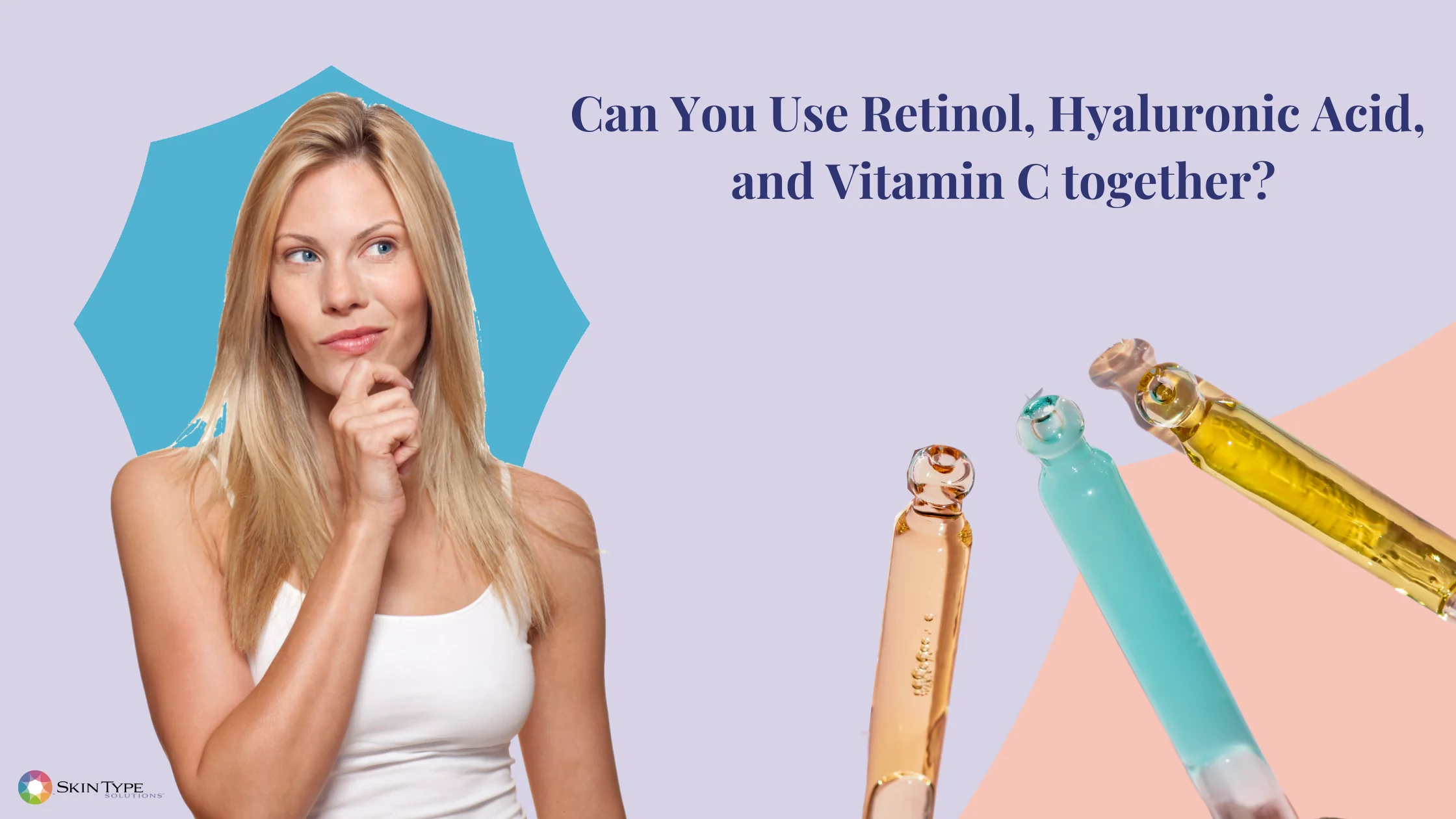Yes, you can use hyaluronic acid with retinol and vitamin C in your skincare routine, but it’s important to understand how to layer them properly to avoid skin irritation and to maximize their effectiveness. Let’s break down how these three powerful skincare ingredients work together, and how to use them for the best results without over-drying or irritating your skin.
How Do Retinol, Vitamin C, and Hyaluronic Acid Work Together?
To use these ingredients effectively, it’s crucial to layer them in the right order and at the right times of day. Here’s a simple breakdown of how they work together:
Vitamin C (Morning Routine):
Vitamin C is a potent antioxidant that helps protect the skin from free radical damage caused by pollution, UV rays, and environmental stressors. It also brightens the skin and helps stimulate collagen production. Using vitamin C in the morning is best for this protective effect.
Retinol (Evening Routine):
Retinol, a form of vitamin A, is a powerful anti-aging ingredient that accelerates cell turnover, smooths wrinkles, and targets fine lines and sagging. It can make your skin more sensitive to the sun, so it’s best used at night.
Hyaluronic Acid (Morning and Night):
Hyaluronic acid (HA) is a humectant that draws moisture into the skin, keeping it hydrated, plumped, and smooth. You can use HA both in the morning and evening, and it can help counteract the dryness and irritation often caused by vitamin C and retinol.
What’s the Best Order for Using These Ingredients?
The general rule for layering skincare products is to go from thinnest to thickest. Here’s how to apply them in the most effective way:
In the morning:
Step 1: Start with a vitamin C serum (it’s usually lightweight and water-based).
Step 2: Apply hyaluronic acid (HA) serum. HA should be applied on slightly damp skin to lock in moisture.
Step 3: Follow with your moisturizer and sunscreen (SPF 30 or higher).
In the evening:
Step 1: Cleanse your skin.
Step 2: Apply hyaluronic acid serum to hydrate and prep your skin.
Step 3: Apply retinol (after HA, as retinol is thicker and can be more effective when applied to hydrated skin).
Step 4: Finish with a nourishing moisturizer.
By following this order, you’ll get the best of both worlds—vitamin C to protect and brighten during the day, retinol to renew and repair overnight, and hyaluronic acid to keep your skin plump, hydrated, and comfortable throughout the process.
Should I Use Hyaluronic Acid Before or After Retinol?
Hyaluronic acid should be used before retinol in your evening routine. Here’s why:
Hyaluronic acid is a humectant that draws moisture into the skin, creating a hydrated base. When your skin is properly hydrated, it absorbs the benefits of retinol better and with less irritation.
Retinol, while incredibly effective at reducing fine lines and boosting collagen, can also be drying. HA helps counteract this by keeping your skin moisturized and plump, preventing the typical dryness and irritation retinol can cause.
Can Vitamin C and Retinol Be Used Together?
It’s generally not recommended to use vitamin C and retinol together in the same routine due to potential irritation, especially if you have sensitive skin. Both ingredients can be drying, and using them at the same time may cause redness, flaking, or peeling. Instead, you should use them at different times of the day:
Vitamin C is best for the morning to protect your skin from UV damage and environmental aggressors.
Retinol is best used at night to promote cell turnover and collagen production while you sleep.
Can I Mix Hyaluronic Acid with Retinol?
Yes, you can mix hyaluronic acid with retinol. In fact, combining the two is a great way to balance the benefits of both. While retinol works to fight fine lines, wrinkles, and pigmentation, hyaluronic acid ensures your skin remains hydrated and prevents the dryness and irritation that can sometimes come with retinol use.
So, apply hyaluronic acid first to lock in moisture and create a hydrated base, then apply your retinol on top to get the full benefits of both ingredients without excessive dryness.
Should Hyaluronic Acid Be Used Before or After Moisturizer?
Hyaluronic acid should generally be applied before moisturizer. This is because HA draws moisture into the skin and locks it in, but it needs a moisturizing barrier to prevent the moisture from evaporating. By applying your moisturizer after HA, you help to seal in the hydration that HA provides, leaving your skin soft, plump, and fully moisturized.
Key Takeaways for Using Hyaluronic Acid, Vitamin C, and Retinol Together
Morning: Vitamin C → Hyaluronic Acid → Sunscreen
Evening: Hyaluronic Acid → Retinol → Moisturizer
Use vitamin C in the morning for protection, retinol at night for anti-aging, and hyaluronic acid twice a day for hydration.
Be cautious with retinol and vitamin C—it’s best to use them at separate times of day to minimize irritation.
Always wear SPF (at least SPF 30) daily when using retinol and vitamin C, as both can increase your skin’s sensitivity to the sun.
By following these steps and understanding how these ingredients work together, you’ll see smoother, brighter, and more youthful-looking skin. If you’re unsure about how to incorporate them into your routine, it’s always a good idea to consult with a dermatologist for personalized advice.
DQH Knowledge drop: In your 20s, your skin cell turnover decreases. (Cell turnover is a key component in keeping your skin youthful.) You know what else slows down? Your collagen production. Starting in your 20s, collagen decreases by about 1 percent per year. Should you want to prevent fine lines and wrinkles, start by eliminating behaviors that contribute to premature aging. “If it’s bad for you, it’s bad for your skin,” says dermatologist Michel Somenek.
“Cigarette smoking reduces blood flow to the skin and causes premature wrinkling and a dull skin texture. Making the repeated pursed motion to inhale can also cause smoker’s lines. Alcohol and recreational drugs are toxins for the skin that damage its cellular structure and DNA,” Somenek tells us. “The faster you eliminate vices while you are young, the better chance your skin and body have to recuperate.” Also, adopting an anti-aging routine in your 20s is key. After all, the best offense is a good defense. We spoke to Somenek and experts Joshua Ross and Audrey Kunin to find out more.
Keep reading for the best anti-aging products for your 20s, according to skincare professionals.
Sunscreen
“We all know that the sun is the number one cause of skin aging and starting the prevention in your 20s is very important,” Ross says. “The majority of your sun damage won’t start to appear until you’re in your 30s, so don’t wait until you see it surface or you’ll be behind the curve. Stay ahead of it with a good-quality zinc-based sunscreen worn daily.”
Farmacy Green Defense Daily Mineral Sunscreen
An invisible sunscreen with SPF 30, plus botanical extracts meant to protect skin with tons of antioxidants. Bonus: It’s clean and fine to use under makeup.
Bareminerals Complexion Rescue™ Tinted Moisturizer Broad Spectrum SPF 30
Although we recommend you use your SPF and moisturizer separately, we also understand moments when you don’t have time or energy for that extra step. For those times, this bareMinerals moisturizer is a great thing to have on hand.
Vitamin C Serum
“A great introduction to anti-aging is to start with a vitamin C serum in your morning skincare routine,” Ross says. “It’s a powerful antioxidant that will neutralize free radicals and brighten the skin.” He adds that it’s a great way to counteract the effects of the sun’s harmful rays, which, as previously mentioned, are among the biggest causes of premature aging.
Drunk Elephant C-Firma™ Vitamin C Day Serum
The Drunk Elephant C-Firma is a lightweight serum that promises to give skin a glow by combining the brightening powers of vitamin C with ferulic acid, l-ascorbic acid, and vitamin E. The included sodium hyaluronate is meant to replace hydration loss, so you shouldn’t have to deal with any irritation.
Sunday Riley C.E.O. Rapid Flash Brightening Serum
This potent serum is jam-packed with vitamin C (15 percent, to be exact), which means it’s a potential superstar at both brightening skin and dousing it in antioxidants.
Peptides
Using peptides on your skin has many benefits, says Somenek. “The skin barrier is what defends the body against pollution, UV rays, bacteria, and toxins. It can be damaged by several everyday factors. Using topical peptides aids in building a stronger barrier,” he says. “Peptides comprise elastic fibers, which are a type of protein. These fibers help to make skin appear taut and firm. Peptides can also help repair damaged skin, relieve inflammation, and even out skin tone. Some peptides can kill acne-causing bacteria that is common in 20-somethings.”
Kunin agrees, saying, “Peptides are an excellent entry point for supporting collagen.” She recommends looking for face and eye treatments that contain these collagen-boosting powerhouses.
Charlotte Tilbury Magic Eye Rescue Cream
This Charlotte Tilbury super-emollient eye cream has a base of coconut oil and shea butter (read: it’s incredibly hydrating). Botanicals plus peptides are meant to help reduce dark circles and boost collagen, respectively.
This creamy moisturizer serves up potent collagen-boosting peptides and pycnogenol, and antioxidant-rich vitamin C. “Instead of sitting on top of the skin, peptides penetrate the outer layer so they go deep. The ‘signals’ they send tell the cells to produce elastin and collagen, which are needed for youthful-looking skin,” explains Somenek.
At-Home Peel Pads
Remember that skin cell turnover fiasco we talked about earlier? One way to help support it is by exfoliating. “Exfoliation is important to help keep skin fresh and luminous,” Kunin says. She recommends using at-home peel pads as an easy and effective way to exfoliate.
“The goal in your 20s is to fight the slowing pace of cell turnover. It is wise to use products that gently exfoliate, yet still remove oil and other impurities. Products that have Alpha Hydroxy Acids (AHA) or Beta Hydroxy Acids (BHA) are a good choice.”
According to Somenek, you should only exfoliate two to three times a week. “People of all ages are guilty of over-exfoliating and that can be too much of a good thing,” he says.
Dermadoctor Kakadu C Intensive Vitamin C Peel Pad
A few swipes of this Derma Doctor powerful peel pad promise to leave your skin glowing and smooth, thanks to the seven (yes, seven) types of chemical exfoliants, including AHA and BHA. It also contains vitamin C via Kakadu plum extract for added brightening and antioxidant protection.
KEY INGREDIENTS Kakadu plum extract is sourced from the Kakadu plum, a fruit grown in northern Australia. It contains vitamin C, which restores the skin’s natural barrier, increases collagen production, and soothes irritation.
Dr. Dennis Gross Skincare Alpha Beta® Universal Daily Peel Pads
These are the gold standard of peel pads, with a cult following and over 900 five-star reviews on Sephora. They’re easy to use and contain a blend of anti-aging exfoliating acids.
Emollient Night Cream
“In your 20s, you need to start upping the hydration in your skincare routine. You may have been cautious of over-moisturizing because of acne in your teens, but as you enter your 20s, your skin transitions and becomes drier,” Ross says. “I recommend an emollient night cream added into your evening skincare regimen.”
“Twenty-somethings need to make sure that they are not using creams that will clog their pores and cause excess oil production,” says Somenek. Opt for non-comedogenic products.
Cerave Skin Renewing Night Cream
One great choice is the CeraVe Skin Renewing Night Cream, which is a non-comedogenic night cream that leaves skin soft and glowy. It combines the moisturizing powers of ceramides and hyaluronic acid.
RoC Retinol Correxion Max Hydration Creme
“The best night cream ingredients contain retinol, benzoyl peroxide, and/or salicylic acid or hyaluronic acid. The goal is to moisturize, yet remove excess oil,” says Somenek. This Roc Retinol Correxion cream fits the bill as it contains both hyaluronic acid and retinol so it promises to moisturize while also being non-comedogenic.



